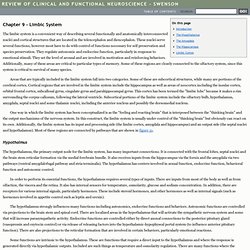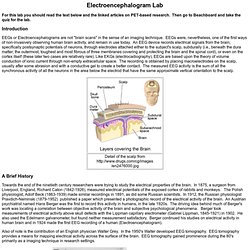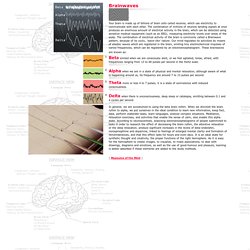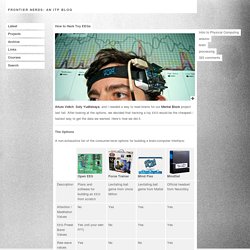

Robert Plutchik's: Psycho Evolutionary Theory of Basic Emotions. What Are Emotions? By Kendra Cherry Updated March 25, 2015.

Question: What Are Emotions? Emotions seem to rule our daily lives. Hippocampus. Psycheducation.org (home) Brain Tours| Memory, Learning, and Emotion: the Hippocampus Emotion and memory are very closely related.

Chapter 9: Limbic System. The limbic system is a convenient way of describing several functionally and anatomically interconnected nuclei and cortical structures that are located in the telencephalon and diencephalon.

These nuclei serve several functions, however most have to do with control of functions necessary for self preservation and species preservation. They regulate autonomic and endocrine function, particularly in response to emotional stimuli. They set the level of arousal and are involved in motivation and reinforcing behaviors. Role of Hypothalamus in Emotion. Hypothalamus sits at the mid-line of the brain just below the thalamus extending to the base of the brain, its size is not larger than the tip of a little finger and it weighs about less than one percent of the brain's entire weight.

Hypothalamus is very vital to both emotion and motivation, thus it is called “the brain within the brain". It is an important brain structure, which through its connections with autonomic nervous system controls glands and smooth muscles, blood vessels and the heart. It influences various kinds of emotional responses accompanied by physiological arousal. The heart rate speeds up, blood circulations from internal organs carrying increased amount of glucose blood sugar to the muscles take place. These "fight" or "flight" emergency responses are the preparatory processes of body for appropriate kind of action and are regulated by the autonomic nervous system under the control of hypothalamus.
The Limbic System" The Limbic System. The Emotional Nervous System.

Url?sa=t&rct=j&q=&esrc=s&frm=1&source=web&cd=4&ved=0CEoQFjAD&url=http%3A%2F%2Focw.mit.edu%2Fcourses%2Fhealth-sciences-and-technology%2Fhst-721-the-peripheral-auditory-system-fall-2005%2Freadings%2Fion_currents.pdf&ei=ind9UqHcJZLmkAfpv4DwBA&usg=AFQjCNG1Ni6. Electric Charge. ALWAYS check the "Summary" and "Key Terms" at the end of the chapters.

KEY TERMS: electric charge, electrostatics, electron, proton, neutron, positive and negative ions, principle of conservation of electric charge, conductor and insulator, induced charge, point charge, Coulomb's law, coulomb, principle of superposition of forces, electric field, test charge, vector field, source point, field point. Before we can discuss DC circuits we need to understand the concept of ELECTRIC CHARGE (Chapter 21) Two Types of Voltage-Dependent Ionic Current - Neuroscience - NCBI Bookshelf. Volume conduction. Figure 1: Isotropic versus 1:10 anisotropic white matter compartment: Volume currents for a thalamic dipole source computed in the finite element volume conductor model from Figure 1 and Figure 1 and visualized on a coronal cut through the models.
(Reprinted from (Wol06), Copyright (2007), with permission from Elsevier) (this figure is animated. If it does no longer flicker to show the difference between isotropic and anisotropic white matter, the page has to be reloaded). Volume conduction, a term used in bioelectromagnetism, can be defined as the transmission of electric or magnetic fields from an electric primary current source through biological tissue towards measurement sensors. Although not a. Electroencephalogram Lab For this lab you should read the text below and the linked articles on PET-based research.

Then go to Beachboard and take the quiz for the lab. Introduction. Brainwaves: Beta ~ Alpha ~ Theta ~ Delta. In general, we are accostumed to using the beta brain rythm.

When we diminish the brain rythm to alpha, we put ourselves in the ideal condition to learn new information, keep fact, data, perform elaborate tasks, learn languages, analyse complex situations. Meditation, relaxation exercises, and activities that enable the sense of calm, also enable this alpha state. How Sound Affects Your Brain. Most of us know that workout songs and music can help you to exercise harder.

But if you understand how sound and music actually change your brain waves, you can use this knowledge to alter your mental and physical performance states with laser accuracy. How to Hack Toy EEGs. Arturo Vidich, Sofy Yuditskaya, and I needed a way to read brains for our Mental Block project last fall.

After looking at the options, we decided that hacking a toy EEG would be the cheapest / fastest way to get the data we wanted. Here’s how we did it. The Options A non-exhaustive list of the consumer-level options for building a brain-computer interface: Open EEG offers a wealth of hardware schematics, notes, and free software for building your own EEG system. Mindflex™ Games - Unleash the power of your mind.
Mindflex Duel Bluetooth Arduino FIO Hack. Mindflex Hack Turns Brain Waves Into Music. By modding a geeky toy and connecting it to a vintage synthesizer, an indie rocker/hacker has created a trippy instrument that lets him make music with his mind. Robert Schneider, singer/guitarist for The Apples in Stereo, made his Teletron by cracking open a Mattel Mindflex, a mind-control game that employs an EEG sensor to let players move a small ball through a maze using nothing but brain waves. “It’s kind of punk-rock,” Schneider told Wired.com in a phone interview about the project.
“You can hack the Mindflex yourself and make brain music.” Schneider’s first mind-control musical performance took place last month at LVL1, a hackerspace in Louisville, Kentucky. EEG: MedlinePlus Medical Encyclopedia. An electroencephalogram (EEG) is a test to measure the electrical activity of the brain. How the Test is Performed Brain cells communicate with each other by producing tiny electrical signals, called impulses. An EEG measures this activity.
The test is done by a EEG specialist in your doctor's office or at a hospital or laboratory. What are emotions, and why do we have them. If you're ever hit in the nose hard enough to make your eyes water, you may also notice that your skin will grow hot, your mouth will go a bit dry and your pulse will become elevated. You'll find that your head begins to swim with a strong desire to hit something in return, possibly to shout while you do.